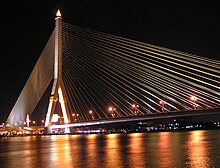Rama VIII Bridge
| Rama VIII Bridge | |
|---|---|

Rama VIII Bridge at night
|
|
| Coordinates | 13°46′9″N 100°29′48.5″E / 13.76917°N 100.496806°ECoordinates: 13°46′9″N 100°29′48.5″E / 13.76917°N 100.496806°E |
| Carries | Road traffic & pedestrians |
| Crosses | Chao Phraya River |
| Locale | Bangkok |
| Maintained by | Bangkok Metropolitan Administration |
| Characteristics | |
| Design | Cable-stayed |
| Total length | 475 m (1,558 ft) |
| Height | 160 m (520 ft) |
| Longest span | 300 m (980 ft) |
| Clearance below | 10.4 m (34 ft) |
| History | |
| Engineering design by | Buckland & Taylor |
| Constructed by |
|
| Fabrication by | BBR Systems |
| Construction begin | 1999 |
| Construction end | 2002 |
| Inaugurated | 20 September 2002 |
| Opened | 7 May 2002 |
| Statistics | |
| Daily traffic | 72,873 |
The Rama VIII Bridge is a cable-stayed bridge crossing the Chao Phraya River in Bangkok, Thailand. It was conceived to alleviate traffic congestion on the nearby Phra Pinklao Bridge. Construction of the bridge took place from 1999 to 2002. The bridge was opened on 7 May 2002 and inaugurated on 20 September, which is the birth anniversary of the late King Ananda Mahidol (Rama VIII), after whom it is named. The bridge has an asymmetrical design, with a single pylon in an inverted Y shape located on the western bank of the river. Its eighty-four cables are arranged in pairs on the side of the main span and in a single row on the other. The bridge has a main span of 300 metres (980 ft), and was one of the world's largest asymmetrical cable-stayed bridges at the time of its completion.
Bangkok is divided by the Chao Phraya River into the main eastern part and Thonburi in the west, with several road bridges linking both sides of the city. By the mid-1990s, traffic congestion on these crossings had become particularly severe. Phra Pinklao Bridge, in particular, was regarded as the worst. With suggestions from King Bhumibol Adulyadej, the Bangkok Metropolitan Administration commissioned studies for the construction of a new bridge north of Phra Pinklao Bridge to alleviate that congestion.
The BMA contracted the British company Mott Macdonald and Thai companies Epsilon and P & Cigna to perform the preliminary survey and designs. Bidding on the project began in 1996, but was halted due to the 1997 Asian financial crisis. The project was revived in 1998 and was awarded as a lump-sum turnkey contract to a joint venture consisting of the Canadian company Buckland & Taylor Ltd., the China State Construction Engineering Corporation, Switzerland-based company BBR Systems Ltd., and the Bangkok-based PPD Construction Co., Ltd. The bridge's design was provided by Buckland & Taylor; its engineers Jorge Torrejon and Don Bergman served as project manager and chief engineer for design. Both had previously worked on the Alex Fraser Bridge in Vancouver, which was the world's longest cable-stayed bridge for five years following its completion in 1986. Construction of the bridge was carried out by the China State Construction Engineering Corp. BBR Systems supplied and installed the cables, and PPD Construction designed the viaducts. London-based Yee Associates served as architect, and Scott Wilson Kirkpatrick (Thailand) provided design management and site services.
...
Wikipedia
